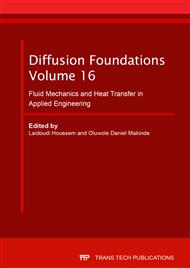p.1
p.12
p.21
p.30
p.45
p.57
p.72
p.84
The Effect of Reynolds and Prandtl Number on Flow inside of Plan Channel of Waved Bottom Wall under Mixed Convection
Abstract:
2D simulations of incompressible fluid in plan channel of waved bottom wall is carried out in this paper to understand and to determine correctly the effects of the Reynolds, Prandtl and Richardson numbers on the fluid flow and heat transfer of waved channel wall. The governing equations involving continuity, momentum and energy are solved numerically based on commercial code which called ANSYS-CFX. The results are presented and discussed for the range of following conditions as: Re = 60 to 250, Pr = 0.7 to 30, Ri = 0 to 1 at fixed value of blockage ratio. The numerical results showed that increase in Richardson number and/ or Prantl number For Reynolds number limited between 60 and 200 increases tightly the heat transfer rate. For the value 250 of Reynolds number increase in the buoyancy strength reduces the value of heat transfer rate.
Info:
Periodical:
Pages:
21-29
Citation:
Online since:
June 2018
Authors:
Keywords:
Price:
Сopyright:
© 2018 Trans Tech Publications Ltd. All Rights Reserved
Share:
Citation:


